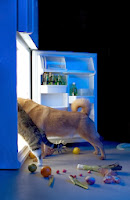By Brianna Backlund, DVM, DACVIM
Thursday, November 21, 2013
As the holiday season
approaches, thoughts of pumpkin pies, gingerbread houses and sugar plum ferries
occupy a lot of our free time. I’ve heard many people joke about going into a
diabetic coma after taking in too much sugar. You may not realize that,
although it’s not quite as straightforward as that, our canine and feline family
members too can have serious consequences from an imbalance in blood sugar
levels.
Is your cat or dog drinking
a lot of water and urinating more than usual? Is your dog losing weight despite
a good appetite or is your cat overweight? If so, then you might take them to
your primary care veterinarian for screening for diabetes mellitus. Cats and
dogs can also develop diabetes, just as humans can. One in 50 to one in 500
cats have diabetes and one in 100 dogs reaching 12 years of age has diabetes.
Diabetes mellitus results
from the body’s cells not being able to use glucose taken in from food or made
by the body for energy. This disease can develop due to a variety of underlying
causes that can make the disease more complicated, but with uncomplicated
diabetes mellitus, its original diagnosis is actually quite straightforward. In
order to make the diagnosis, your veterinarian will simply need to collect
blood and urine samples for testing with the goal of identifying high blood
glucose levels with glucose in the urine. Just like people, diabetic pets often
need a diet change as well as injections of insulin to allow glucose to enter
the cells and provide them with the needed energy to function. Many of the
insulin types used are the same as those used for human diabetics. As you can
imagine, it is difficult to manage a human with diabetes. It can be just as
difficult, if not more so, to undertake this care for a diabetic dog or cat.
As a general rule, this is a
chronic disease condition that can respond well to appropriate insulin
injections. If these subtle signs however have gone unnoticed for an extended
amount of time, the body can only cope for so long without an appropriate
supply of energy to the cells and your pet can develop an emergent condition
called diabetic ketoacidosis (DKA). When your pet becomes very ill with DKA,
they will most likely need to be taken to the ER for hospitalization, monitoring,
supportive care, and starting insulin therapy.



